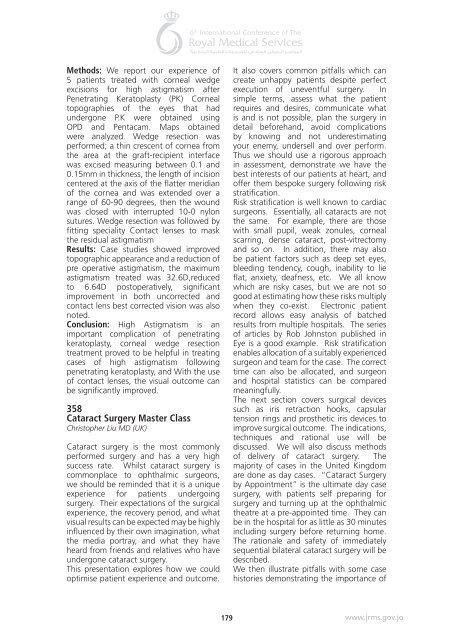Abstract book 6th RMS 16.indd
Abstract book 6th RMS 16.indd
Abstract book 6th RMS 16.indd
You also want an ePaper? Increase the reach of your titles
YUMPU automatically turns print PDFs into web optimized ePapers that Google loves.
Methods: We report our experience of<br />
5 patients treated with corneal wedge<br />
excisions for high astigmatism after<br />
Penetrating Keratoplasty (PK) Corneal<br />
topographies of the eyes that had<br />
undergone P.K were obtained using<br />
OPD and Pentacam. Maps obtained<br />
were analyzed. Wedge resection was<br />
performed; a thin crescent of cornea from<br />
the area at the graft-recipient interface<br />
was excised measuring between 0.1 and<br />
0.15mm in thickness, the length of incision<br />
centered at the axis of the flatter meridian<br />
of the cornea and was extended over a<br />
range of 60-90 degrees, then the wound<br />
was closed with interrupted 10-0 nylon<br />
sutures. Wedge resection was followed by<br />
fitting speciality Contact lenses to mask<br />
the residual astigmatism<br />
Results: Case studies showed improved<br />
topographic appearance and a reduction of<br />
pre operative astigmatism, the maximum<br />
astigmatism treated was 32.6D,reduced<br />
to 6.64D postoperatively, significant<br />
improvement in both uncorrected and<br />
contact lens best corrected vision was also<br />
noted.<br />
Conclusion: High Astigmatism is an<br />
important complication of penetrating<br />
keratoplasty, corneal wedge resection<br />
treatment proved to be helpful in treating<br />
cases of high astigmatism following<br />
penetrating keratoplasty, and With the use<br />
of contact lenses, the visual outcome can<br />
be significantly improved.<br />
358<br />
Cataract Surgery Master Class<br />
Christopher Liu MD (UK)<br />
Cataract surgery is the most commonly<br />
performed surgery and has a very high<br />
success rate. Whilst cataract surgery is<br />
commonplace to ophthalmic surgeons,<br />
we should be reminded that it is a unique<br />
experience for patients undergoing<br />
surgery. Their expectations of the surgical<br />
experience, the recovery period, and what<br />
visual results can be expected may be highly<br />
influenced by their own imagination, what<br />
the media portray, and what they have<br />
heard from friends and relatives who have<br />
undergone cataract surgery.<br />
This presentation explores how we could<br />
optimise patient experience and outcome.<br />
It also covers common pitfalls which can<br />
create unhappy patients despite perfect<br />
execution of uneventful surgery. In<br />
simple terms, assess what the patient<br />
requires and desires, communicate what<br />
is and is not possible, plan the surgery in<br />
detail beforehand, avoid complications<br />
by knowing and not underestimating<br />
your enemy, undersell and over perform.<br />
Thus we should use a rigorous approach<br />
in assessment, demonstrate we have the<br />
best interests of our patients at heart, and<br />
offer them bespoke surgery following risk<br />
stratification.<br />
Risk stratification is well known to cardiac<br />
surgeons. Essentially, all cataracts are not<br />
the same. For example, there are those<br />
with small pupil, weak zonules, corneal<br />
scarring, dense cataract, post-vitrectomy<br />
and so on. In addition, there may also<br />
be patient factors such as deep set eyes,<br />
bleeding tendency, cough, inability to lie<br />
flat, anxiety, deafness, etc. We all know<br />
which are risky cases, but we are not so<br />
good at estimating how these risks multiply<br />
when they co-exist. Electronic patient<br />
record allows easy analysis of batched<br />
results from multiple hospitals. The series<br />
of articles by Rob Johnston published in<br />
Eye is a good example. Risk stratification<br />
enables allocation of a suitably experienced<br />
surgeon and team for the case. The correct<br />
time can also be allocated, and surgeon<br />
and hospital statistics can be compared<br />
meaningfully.<br />
The next section covers surgical devices<br />
such as iris retraction hooks, capsular<br />
tension rings and prosthetic iris devices to<br />
improve surgical outcome. The indications,<br />
techniques and rational use will be<br />
discussed. We will also discuss methods<br />
of delivery of cataract surgery. The<br />
majority of cases in the United Kingdom<br />
are done as day cases. “Cataract Surgery<br />
by Appointment” is the ultimate day case<br />
surgery, with patients self preparing for<br />
surgery and turning up at the ophthalmic<br />
theatre at a pre-appointed time. They can<br />
be in the hospital for as little as 30 minutes<br />
including surgery before returning home.<br />
The rationale and safety of immediately<br />
sequential bilateral cataract surgery will be<br />
described.<br />
We then illustrate pitfalls with some case<br />
histories demonstrating the importance of<br />
179 www.jrms.gov.jo

















